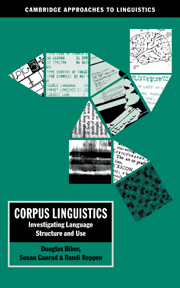Book contents
- Frontmatter
- Contents
- Preface
- 1 Introduction: goals and methods of the corpus-based approach
- Part I Investigating the use of language features
- Part II Investigating the characteristics of varietie
- 6 Register variation and English for Specific Purposes
- 7 Language acquisition and development
- 8 Historical and stylistic investigations
- Part III Summing up and looking ahead
- Part IV Methodology boxes
- Appendix: commercially available corpora and analytical tools
- References
- Index
7 - Language acquisition and development
Published online by Cambridge University Press: 05 June 2012
- Frontmatter
- Contents
- Preface
- 1 Introduction: goals and methods of the corpus-based approach
- Part I Investigating the use of language features
- Part II Investigating the characteristics of varietie
- 6 Register variation and English for Specific Purposes
- 7 Language acquisition and development
- 8 Historical and stylistic investigations
- Part III Summing up and looking ahead
- Part IV Methodology boxes
- Appendix: commercially available corpora and analytical tools
- References
- Index
Summary
Introduction
Research in language acquisition and development has focused on three major areas: 1. the first-language acquisition of very young children; 2. later language development, such as the acquisition of literacy skills, by students at various stages; and 3. second-language acquisition, by children and adults. In all three areas, studies have traditionally been of two major types: experimental or observational. Experimental studies involve the use of a specially designed instrument to try to test directly what a speaker knows at a given stage. In contrast, observational studies are based on the natural language production of learners. As such, observational studies have usually used a kind of corpus-based approach – collecting a series of texts from different stages of acquisition or from different learners, and then analyzing the linguistic patterns in those texts.
For example, observational studies of early first-language acquisition have often been based on recordings of a child made at regular intervals over a period of several months. The transcripts of the child's speech thus comprise the texts for the study. Studies of later language development have sometimes been based on collections of texts from a larger number of students, such as essays written by students in a particular class.
For the most part, however, these observational studies have not employed modern corpus-based techniques. That is, few studies have collected a systematic corpus of texts, entered those texts into a computer, and used computational tools to aid in the analysis of language use patterns.
- Type
- Chapter
- Information
- Corpus LinguisticsInvestigating Language Structure and Use, pp. 172 - 202Publisher: Cambridge University PressPrint publication year: 1998

